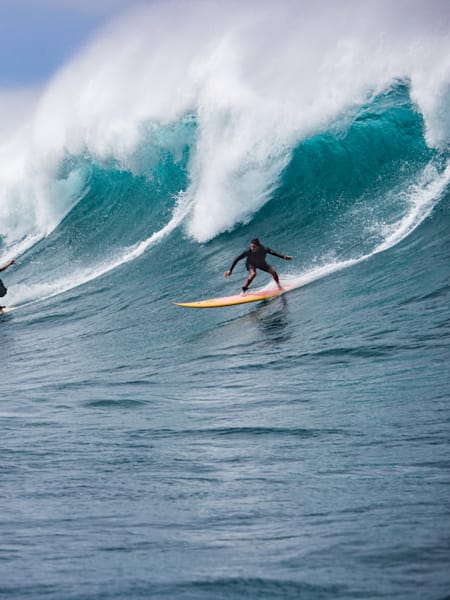
Surfing
Understanding surfboard tail shapes is the first step to unlocking the full potential of your equipment.
There are so many different kinds of surfboards that it can be challenging for a beginner or even an advanced surfer to know which to pick. Surfers at all levels usually like to try different types of boards. Developing your own personal collection of surfboards, also known as your “quiver,” will involve trial and error.
While many aspects of a surfboard affect performance, like length, volume, rocker, and bottom contour, one of the most important is the tail shape. The four types of surfboard tails outlined in this article–squash, pin, round, and swallow–are each suited for certain types of waves and styles of surfing.
4 Different Surfboard Tail Shapes and Their Purpose
01
The Squash Tail
The squash tail is one of the most common square tail shapes and one of the most versatile. It is generally defined as a rounded square tail with a flat end and curved corners. Squash tails can range from more narrow “pulled in” tails to wider “stubby” or “block” tails. The wider the tail, the more “loose” the board will feel in turns because there will be more surface area, so it will have less traction or “grip” in the water and will be easier to maneuver.
Squash tails are the most common shape used by professional surfers because they are very maneuverable. It can be used in various conditions but is better for maneuvers than for going straight. A wider tail won’t sink as deep into the water, making it easier to move from rail to rail in turns. The large surface area of this style tail also helps to provide extra stability for beginners.
02
The Pin Tail
The pintail, not to be confused with a round tail, is curved but comes to a sharp point at the end. This shape is only used in advanced conditions like big wave surfing or barrel surfing. This should only be used by highly experienced surfers. It is generally found on a thin board with low stability and maneuverability. It would be very hard to use in average conditions.
For surfers with the ability and proper safety training to ride expert-level waves, pintails help the board grip the water at high speeds. The thin tail sinks into the water, which gives more traction and hold, as there is less surface area. This is the ideal board type for waves when you just want to go straight and fast rather than have the flexibility to make turns.
03
The Round Tail
The round tail is a hybrid between a maneuverable squash tail and a high-traction pintail. There is more surface area than a pintail, which will make the board easier to turn, but less than a squash tail, which will give the board more grip in the water.
This type of board is ideal for maneuvers in bigger waves or for medium-sized barrels. It will give the hold and confidence to go straight when needed and the ability to turn if you see a big section down the line.
04
The Swallow Tail
The swallowtail can be found on performance shortboards as well as wider fishes. It looks the most distinct from other tail shapes because it is deeply forked and tapers to two points. This shape is suitable for generating speed and providing grip in bigger waves. Depending on what type of board it’s paired with, this tail shape can be helpful in small or massive waves.
Paired with a wide board, a swallowtail helps generate speed by adding more surface area on the tail. When paired with a board for bigger waves– like a “step-up”– the surface area and double points on the tail help add additional traction. And extra space in the center for water to flow around the board to propel a surfer forward.
There’s a lot to consider when picking a surfboard. While a new surfboard won’t always make you a better surfer, the wrong equipment choice can leave you struggling and feeling defeated. That’s why many pro surfers have collections of hundreds of surfboards. Professional surfers often work with different surfboard shapers worldwide to develop boards for a particular wave. Understanding tail shapes is the first step to unlocking the full potential of your equipment.




